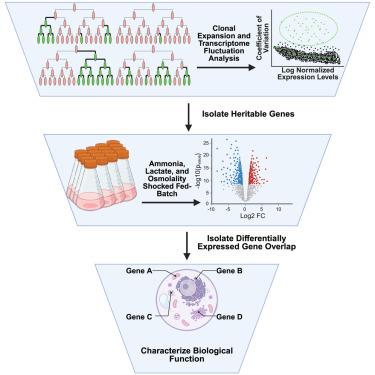MemorySeq鉴定了CHO细胞中启动细胞培养应激耐受性的可遗传表观遗传表型
IF 4.1
2区 综合性期刊
Q1 MULTIDISCIPLINARY SCIENCES
引用次数: 0
摘要
在批量生产过程中,中国仓鼠卵巢(CHO)细胞会遇到临界水平的环境应激源,这会显著降低细胞的健康和生产力。因此,在选择合适的宿主时必须考虑应力耐受性。在本研究中,我们采用基于群体的转录组学方法(称为MemorySeq)和应激休克CHO细胞的差异基因表达分析来鉴定应激反应生物标志物。这些生物标志物表现出短暂和中间的遗传记忆状态,具有表观遗传开关和转录爆发的特征。利用这一工作流程,199个基因表现出双状态系统的转录变异性特征,并形成了四个共波动基因的网络社区。这些群落富含与凋亡过程、基因表达和代谢途径调控相关的基因。7个基因被确定为有希望的抗逆性生物标志物。在未来,基因工程方法可能被用于使无性系群体对制造胁迫具有更高的耐受性。本文章由计算机程序翻译,如有差异,请以英文原文为准。

MemorySeq identifies heritable epigenetic phenotypes that initiate cell culture stress tolerance in CHO cells
During manufacturing batches, Chinese hamster ovary (CHO) cells encounter critical levels of environmental stressors which can significantly reduce cell health and productivity. Therefore, stress tolerance must be considered during selection of a suitable host. In this study, we employ a population-based transcriptomic method, referred to as MemorySeq, and differential gene expression analysis on stress-shocked CHO cells to identify stress responsive biomarkers. These biomarkers exhibit transient and intermediate heritable memory states characteristic of epigenetic switches and transcriptional bursting. Using this workflow, 199 genes were found to exhibit transcriptional variability characteristic of two-state systems with switching that forms four network communities of co-fluctuating genes. These communities were enriched in genes related to the regulation of apoptotic processes, gene expression, and metabolic pathways. Seven genes were identified as promising biomarkers of stress-resistance. Genetic engineering methods may be employed in the future to bias clonal populations toward higher stress tolerance to manufacturing stress.
求助全文
通过发布文献求助,成功后即可免费获取论文全文。
去求助
来源期刊

iScience
Multidisciplinary-Multidisciplinary
CiteScore
7.20
自引率
1.70%
发文量
1972
审稿时长
6 weeks
期刊介绍:
Science has many big remaining questions. To address them, we will need to work collaboratively and across disciplines. The goal of iScience is to help fuel that type of interdisciplinary thinking. iScience is a new open-access journal from Cell Press that provides a platform for original research in the life, physical, and earth sciences. The primary criterion for publication in iScience is a significant contribution to a relevant field combined with robust results and underlying methodology. The advances appearing in iScience include both fundamental and applied investigations across this interdisciplinary range of topic areas. To support transparency in scientific investigation, we are happy to consider replication studies and papers that describe negative results.
We know you want your work to be published quickly and to be widely visible within your community and beyond. With the strong international reputation of Cell Press behind it, publication in iScience will help your work garner the attention and recognition it merits. Like all Cell Press journals, iScience prioritizes rapid publication. Our editorial team pays special attention to high-quality author service and to efficient, clear-cut decisions based on the information available within the manuscript. iScience taps into the expertise across Cell Press journals and selected partners to inform our editorial decisions and help publish your science in a timely and seamless way.
 求助内容:
求助内容: 应助结果提醒方式:
应助结果提醒方式:


